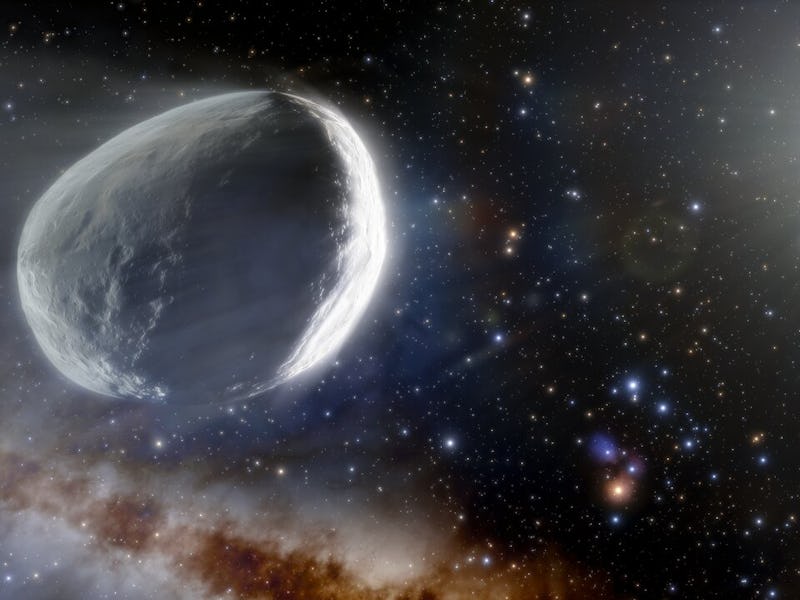Astronomers finally figure out the size of the largest comet ever found — and it's twice as big as Rhode Island
We shouldn’t read too much into it being the size of the Death Star ... probably.

New observations by Hubble of the largest comet ever found are confirming its status as a titan of icy space objects. Comet C/2014 UN271 measures about 74 miles across, according to updated data, and weighs in at about 500 trillion tons.
That’s really big — for reference, the asteroid that killed the dinosaurs was about six miles in diameter — and significantly bigger than the previous record-holder, comet C/2002 VQ94 (LINEAR), which is thought to be about 60 miles in diameter. Most comets found so far measure no more than a few miles across.
C/2014 UN271 was first discovered in data from the Dark Energy Survey, a project that involved surveying wide swaths of the sky in multiple wavelengths. Astronomers made initial estimates of the comet’s size last year, and followed up with a more detailed analysis in a paper published in April in the The Astrophysical Journal Letters.
The nucleus of UN271 is big — but there might be bigger ones lurking that far out.
How did astronomers figure out C/2014 UN271’s size?
Figuring out the comet’s size actually turned out to be a bit of a challenge. C/2014 UN271 is surrounded by a cloud of gas and dust, and it’s so far away that getting a good image is tough. The initial images of the comet weren’t good enough to do more than estimate its size. It took Hubble’s high-resolution camera, as well as input from radio telescopes, to nail down a better measurement.
UN271’s diameter of 74 miles is 44 Golden Gate bridges lined up end to end, and it’s about twice the diameter of Rhode Island. On a more suspicious note, it’s also the exact size of the first Death Star in Star Wars Episode IV: A New Hope. We probably shouldn’t read anything into that … probably.
This massive chunk of frozen water, rocks, and other elements comes from the Oort Cloud, a huge region surrounding the Sun that starts far, far beyond the orbit of Neptune.
“The Oort Cloud is this filled sphere of comets that goes out to crazy distances,” David Jewitt, an astronomer at UCLA and co-author of the paper, tells Inverse. “It’s about a quarter of the way to the nearest star — it’s really, really big.”
The Oort Cloud is so far away that astronomers can’t make out individual objects in it, Jewitt says. The only evidence we have for their existence is comets like C/2014 UN271, which have likely had their orbits changed by the gravitational influence of passing stars. C/2014 UN271 has an orbit that takes millions of years to complete and which sees it fly hundreds of billions of miles away.
The comet is currently about 1.8 billion miles away from Earth, or about as far away as Uranus, and it’ll pass just outside Saturn’s orbit in 2031 at its closest point to the Sun — meaning we don’t need to worry about Don’t Look Up playing out in real life.
The actual observations of the comet helped astronomers match up the size of its nucleus.
What is comet C/2014 UN271 made of?
Like all comets that get close to the Sun, C/2014 UN271 is surrounded by a coma, or a large cloud of gas that’s sublimating off of the comet’s surface. That cloud is what gives comets their tails, and they can be huge — the part of C/2014 UN271’s coma that the astronomers could see in their images is more than 150,000 miles long, Jewitt estimates.
The comet is currently too far out, and therefore too cold, for water to turn into a gas, so it’s likely that the coma is made of things that turn into a gas at much lower temperatures, like carbon monoxide. The comet is probably losing more than 2,000 pounds of material every second, Jewitt says, as its body turns straight from a solid to a gas.
That coma also made it tough for the astronomers to get an accurate estimate of how big C/2014 UN271 actually is. The cloud of gas glows brightly with reflected sunlight, and the actual comet, or nucleus, can get lost inside that glare. To zoom in on the comet itself, Jewitt and his coauthors relied on Hubble’s resolving power to separate out light from the comet itself from light coming from the cloud of gas surrounding. Then, using radio-wave data from the Atacama Large Millimeter/submillimeter Array (ALMA), they were able to find the comet’s albedo, or how reflective it is, which helped to further refine estimates of its size.
For an object made out of ice, C/2014 UN271 actually isn’t very shiny. In fact, Jewitt says, like many comets, the object is actually really dark, with an albedo of just three percent (lower albedos correspond to less reflectivity).
“It’s almost blacker than black,” he says.
Discovering one mega-sized comet from the Oort Cloud is also an indication that there are many more to find, Jewitt says. At the moment, our telescopes are only good enough to find really big objects so far away, meaning that countless smaller ones are going undetected.
“When we get better data from bigger, deeper sky surveys, we will see a lot more,” he says. “For every one of these guys, the big ones, there’s ten or twenty thousand [half mile] objects, probably.”
This article was originally published on